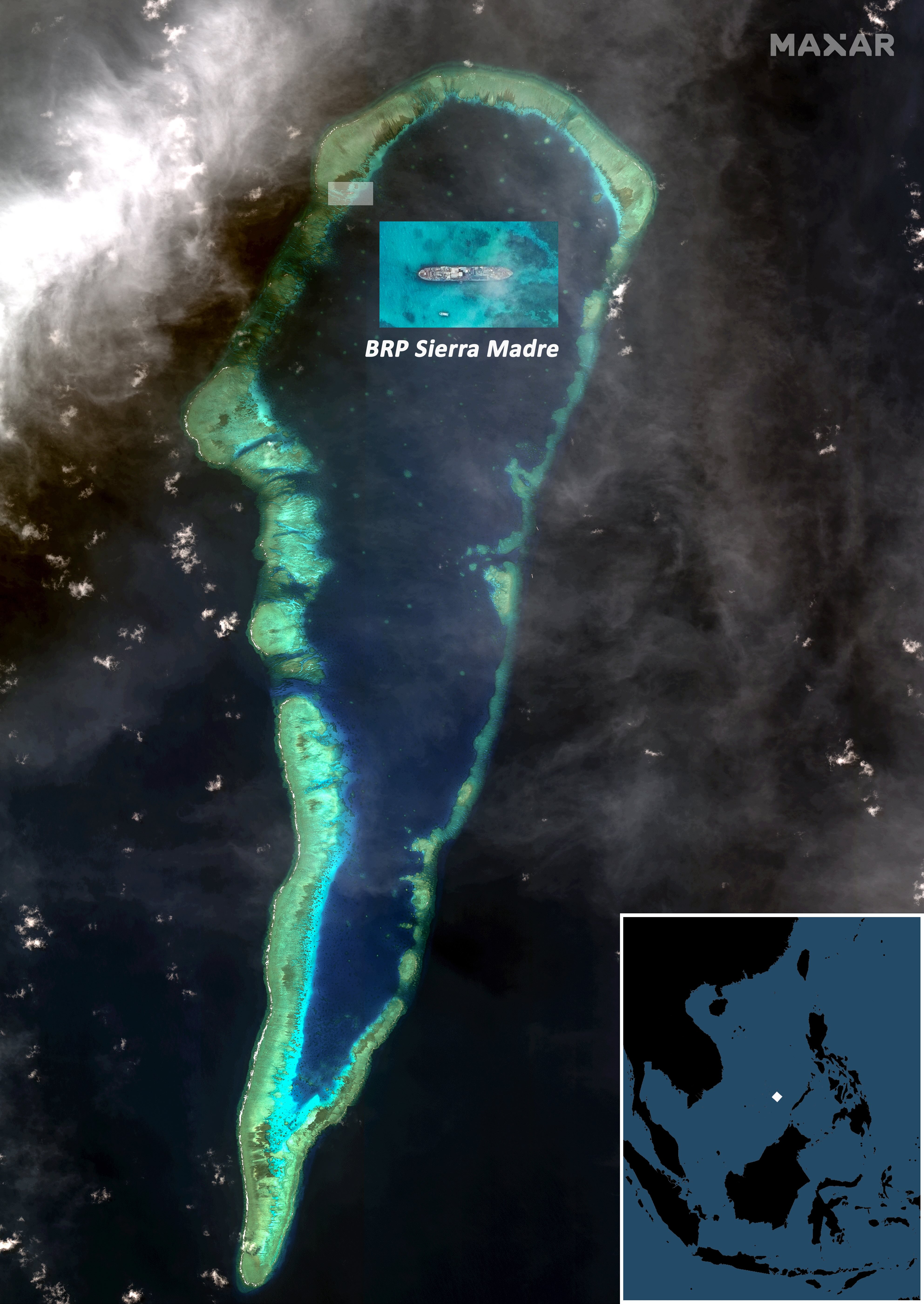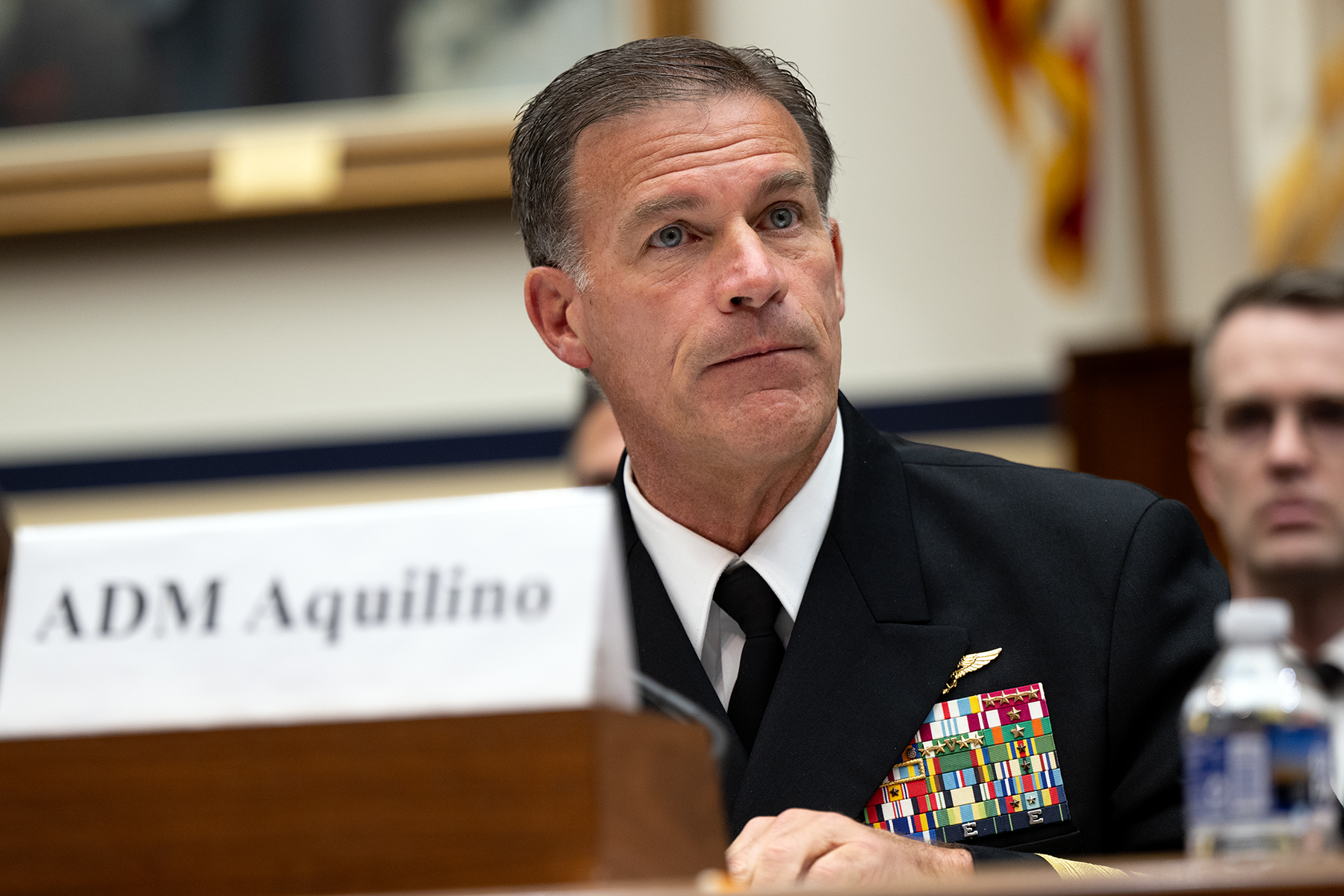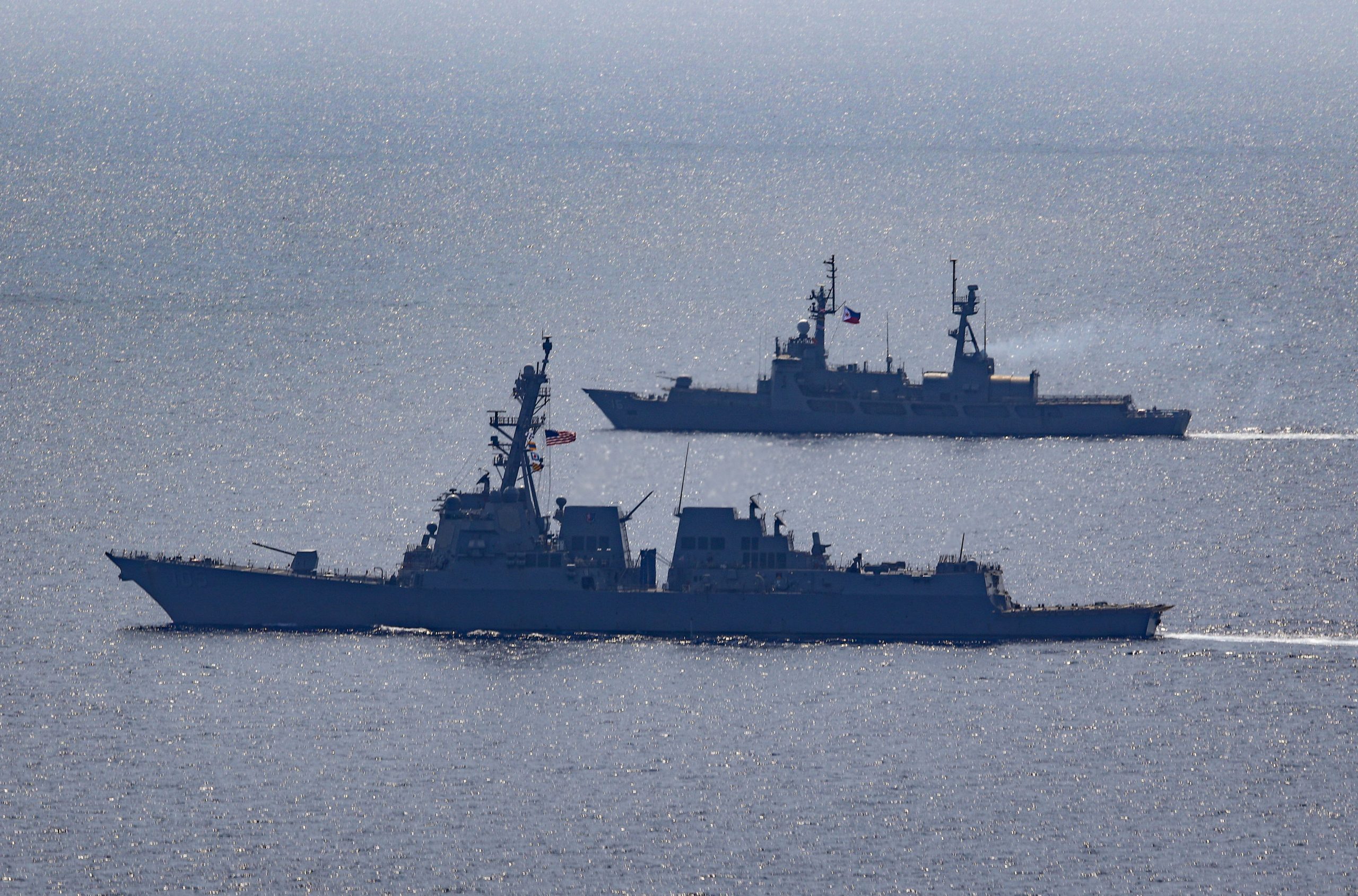
Six days after China Coast Guard cutters blasted out the windows of a Philippine resupply ship with a water cannon, Manila is weighing whether a 70-year-old mutual defense pact could compel the U.S. military to defend Filipino forces in the South China Sea as a result.
On March 23, the Philippine Navy-operated, civilian-contracted resupply ship Unaizah Mae 4 was attempting to resupply the BRP Sierra Madre outpost on the disputed Second Thomas Shoal when two Chinese cutters fired water cannons on the ship. According to footage released by the Armed Forces of the Philippines, the high-pressure blasts blew out windows on the bridge of Unaizah Mae 4 and injured sailors aboard.
The attack, the ninth and most aggressive since Chinese cutters restarted a campaign blocking the monthly resupply runs to the World War II-era Sierra Madre, is prompting politicians, analysts and lawyers across the Pacific to weigh the U.S. obligation to come to Manila’s aid under a 1951 mutual defense pact.
Both the U.S. State and Defense departments issued statements this week pledging commitment to the treaty.
“The United States reaffirms that Article IV of the 1951 U.S.-Philippines Mutual Defense Treaty extends to armed attacks on Philippine armed forces, public vessels, or aircraft – including those of its Coast Guard – anywhere in the South China Sea,” reads the statement from Foggy Bottom.
While the worst-case scenario under the defense treaty could lead to open war with China, the agreement has options for the U.S. to support Manila diplomatically short of armed conflict. However, the 1951 treaty’s application in the 21st century raises questions about whether the Chinese use of water cannons constitutes an armed attack or if the resupply missions are categorized as civilian or military, opening up several legal interpretations.
Rust Bucket Resupply

The rusting hulk of the Sierra Madre – originally the U.S. World War II tank landing ship USS Harnett County – has been beached on Second Thomas Shoal since 1999, when the Philippines deliberately grounded the vessel to stake its claim to the sandbank. Second Thomas Shoal is about 120 miles east of the Philippine island of Palawan – well inside the country’s exclusive economic zone – and just inside China’s expansive nine-dash line claim in the South China Sea. Just 20 miles west, Beijing created a Chinese military outpost on Mischief Reef from a similar low-tide feature.
Since Sierra Madre’s grounding, Filipino Marines have maintained a presence on the shoal as a hedge against Chinese encroachment toward Palawan. They receive supplies every few weeks. A Philippine Coast Guard vessel typically escorts smaller civilian-chartered vessels that have Filipino Navy sailors aboard. Those smaller civilian vessels, like Unaizah Mae 4 , carry and transfer the supplies.
But the ambiguous civilian status of those ships raises some questions, like whether firing water cannons on the Unaizah Mae while it had Filipino sailors aboard constituted an armed attack against a vessel or service members.
“That’s the question … that needs clarification,” Julio Amador, an analyst based in Manila, told USNI News. “It’s getting more dangerous [to resupply the Sierra Madre] given the news that we see, that navy sailors are actually getting hurt by all of this bombardment by the [People’s Republic of China Coast Guard].”
“It’s very clear that it’s Navy personnel inside those resupply vessels, so I don’t think the Chinese are remiss, or don’t think that [the Chinese] can claim ignorance about who is inside,” he added.
The decision to use civilian vessels dates back to the administration of former Philippine President Benigno Aquino, according to Jay Batongbacal, a law professor at the University of the Philippines. The idea was to make the missions look less “provocative” while still resupplying the garrison, he said.
“They thought that by using these civilian vessels, it would be a safer way of conducting this activity,” Batongbacal told USNI News. “Obviously that situation has completely changed.”
Back in Washington

Testifying before the House Armed Services Committee last week, outgoing U.S Indo-Pacific Command chief Adm. John Aquilino described the Philippines as a “really critical hotspot” that he is worried about because of the China Coast Guard’s increasing aggression toward the Sierra Madre resupply missions.
“I’m concerned where it could go,” Aquilino told lawmakers.
In 2016, an international tribunal ruled against Beijing’s expansive claims in the South China Sea and said China had no legal claim to the Second Thomas Shoal or its surrounding waters.
But China ignored the Hague’s ruling. China Coast Guard cutters, maritime militia and People’s Liberation Army Navy warships continue to restrict access around the features in the Spratly Islands.
In his testimony, Aquilino noted the escalation and other countries’ rebuke of the Chinese attacks.
“I would hope that the international community condemnation of those actions is enough to get the Chinese to back off,” Aquilino told the committee. “But if it doesn’t, it could go in bad places. The Philippines, if a sailor or soldier or one of their members were killed, could invoke Article V of the Mutual Defense Treaty. And that would put our policy decision makers in a place that would require really tough choices. It would be my requirement and responsibility to provide the secretary with options if that were to happen.”
Tatlong opisyal ng Philippine Navy ang nagtamo ng injury sa kanilang mata at ulo matapos atakihin ng China Coast Guard vessels ang Philippine supply vessel malapit sa Ayungin Shoal nitong Sabado, March 23. #News5 | via @_GioRobles pic.twitter.com/L8DBw4XO0Q
— News5 (@News5PH) March 25, 2024
Article V of the Mutual Defense Treaty between the U.S. and the Philippines states that “an armed attack on either of the Parties is deemed to include an armed attack on the metropolitan territory of either of the Parties, or on the island territories under its jurisdiction in the Pacific or on its armed forces, public vessels or aircraft in the Pacific.”
In statements this week, Chinese defense and foreign affairs officials warned Manila against seeking international aid.
“The Chinese side will not allow the Philippines to act willfully and that’s why China has responded with legitimate resolute and restrained actions,” Chinese military spokesman Senior Col. Wu Qian said in a statement Thursday. “The Philippine side should realize that provocations will only do themselves more harm than good, and soliciting foreign support will lead nowhere.”
Under the treaty Manila and Washington have alternative options to armed conflict, Batongbacal told USNI News. Diplomatic solutions are covered under the first three articles, including providing mutual aid and participating in conversations between foreign ministers. There are also levels of proportionality within any invocation of Article V.
“Many think that when you say you invoke the MDT, you’re going to get the ally to engage in armed conflict for you,” Batongbacal said. “That’s the common misunderstanding of the MDT. And I think that for the [Philippine] Armed Forces, that has also been rather prevalent because [of] the simple fact that there has never been a need to invoke the MDT for anything for quite a long time.”

In one potential scenario, the U.S. could come to the aid of a Philippine vessel attacked by the Chinese. If the Chinese Coast Guard continued its attacks and turned those actions toward the U.S. vessel, the American ship could reasonably respond in self-defense under the rules of engagement, Batongbacal said.
Though the treaty is flexible, Batongbacal argued the U.S. and the Philippines need to show China that they are willing to invoke the MDT. Otherwise, he said, the treaty’s deterrent effect will be diminished.
“Right now China is very confident that the Philippines will surrender because it has no appetite to invoke the MDT and the U.S. will not have any appetite either to apply the MDT,” he said. “So it’s calculating that it can get away with just about anything as long as it does not give any reason for outright war.”
While an armed attack is not defined within the treaty, lawyers at INDOPACOM say the U.S. historically views “self-defense against an armed attack” as pertaining to “any illegal use of force.”
According to the guidance, which was last updated March 10, “an illegal use of force is not limited by law to a kinetic armed attack (e.g. the use of munitions), but could also include non-kinetic attacks that result in death, injury, damage, or destruction of persons or objects.”
China’s Coast Guard stopped using water cannons in 2021, but resumed in August 2023 and has fired on four resupply missions since November.
“I think that this interpretation of INDOPACOM actually now means that INDOPACOM considers even these non-kinetic means, particularly means that do not involve munitions – it specifies that – it now considers these acts valid basis for invoking the MDT,” Batongbacal said.
View from Manila
WATCH | China Coast Guard started blasting water canon directed at Unaizah May 4 around 7:59AM deliberately targeting and hitting the supply boat.#OneAFPOnePHILIPPINES#StrongAFPStrongPHILIPPINES#AFPyoucanTRUST pic.twitter.com/Y0xZdVMshd
— Armed Forces of the Philippines (@TeamAFP) March 23, 2024
Since the attack on the resupply mission last week, officials in Manila have promised to respond. In a March 28 statement on X, Philippine President Ferdinand Marcos said he has conversed with domestic leaders and international allies about China’s ongoing aggression.
“Over the succeeding weeks there shall be, implemented by the relevant national government agencies and instrumentalities, a response and countermeasure package that is proportionate, deliberate, and reasonable in the face of the open, unabating, and illegal, coercive, aggressive, and dangerous attacks by agents of the China Coast Guard and the Chinese Maritime Militia,” Marcos said.
On Wednesday, Philippine Defense Minister Gilberto Teodoro consulted with U.S. Defense Secretary Lloyd Austin, according to a Pentagon readout.
“[Austin] emphasized U.S. support for the Philippines in defending its sovereign rights and jurisdiction, and reiterated that the U.S.-Philippines Mutual Defense Treaty extends to both countries’ armed forces, public vessels, and aircraft — including those of its Coast Guard — anywhere in the Pacific, to include the South China Sea,” reads the statement. “They highlighted that the 2016 Arbitral Tribunal Ruling is final and binding on the Parties and called on [China] to abide by its obligations under international law.”
Following comments from China on Thursday urging Manila to back down, the Philippine Department of National Defense issued a statement with the heading, “Filipinos do not yield.”
“[China’s] repertoire consists of only patronizing, and failing that, intimidating smaller countries,” reads the statement. “We will never seek a fight or trouble. Neither will we be cowed into silence, submission or subservience. We do not yield. We are Filipinos.”




